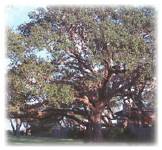Panhandle Plantings

The Care and Feeding of Worms, Bacteria and Fungi
Let’s adjust our perception of our gardens for a moment or two.
Think of your plants as miniature solar panels – that’s what photosynthesis is – the collection of solar energy and it’s transformation into a useful commodity, in this case carbohydrates. Plants require these carbohydrates to live, but they also transfer 20 to 40 percent of their total carbohydrate production into the soil via their root systems.
As long as there are plants (solar panels) on the soil surface, there’s energy to maintain the nutrient rich environment surrounding the fine root hairs (solar transmitters) underground – and it’s here that beneficial bacteria and fungi feed, breed and work. When earthworms are added to the mix, they work to break down surface level organic matter (mulch!) by processing it through their systems as nutrient rich and pH neutral castings. These are then transferred to the lower levels of the soil structure, via tunnels that provide soil aeration and increased tilthe (providing additional nutrients – energy -- to the “solar panels”).
This is a pretty peaceful, effective and efficient gardening scenario when you get right down to it. But there is a constant danger to this well coordinated universe. As the great philosopher Pogo once said: “We have met the enemy and they are us.”
First and foremost is our fascination with tilling, plowing and turning the soil. Once you’ve broken ground for the garden space, sell the tiller! As your garden establishes, so do the threads of beneficial fungi and earthworm tunnels. Every time you tear through the soil, you destroy these, as well as soil texture.
Second, we don’t always need to “work compost into the soil” – once the initial garden preparation is completed, this is just a means of deluding ourselves into believing that we’re not tilling. Buy some worms! Every six months, when you amend organic matter, do so by applying an inch of compost to the soil surface, and then mulch another three to six inches. The worms will take care of transferring the decomposing organic matter into the soil without disturbing the existing infrastructure.
Third, maintain the three to six inch layer of mulch year round. This maintains a constant supply of organic matter to the soil, increases the amount of rainwater that enters the soil by decreasing the amount of run off, and prevents heavy rains from compacting the soil.
Fourth, if you choose to use chemical or high-nitrogen fertilizers, use them according to directions. Both can burn and/or destroy fine root hairs that would normally provide the carbohydrate rich feeding grounds for bacteria and fungi.
Fifth, determine walking paths and stick to them! One footstep creates six to ten pounds of pressure per square inch on your soil. This results in compaction that eliminates air pockets and inhibits root expansion in planting areas, both of which are detrimental to our little underground society.
Finally, if you don’t maintain a year round garden, you may want to consider a ‘cover crop’ during the down time. This would provide a stable environment for maintaining the carbohydrate-rich root zone areas as well as air and water pathways along root paths and earthworm tunnels. A thick cover crop can prevent weed growth, moderate soil temperature and provide organic mulch as it is cut or dies-back with the season changes.
With apologies to Mr. Churchill, I’ll close with a quote from a 1950 election address that seems appropriate here – albeit with a different twist: “Above all things we must make sure that our foundations are not undermined.”
Val Ford is a Holmes County Master Gardener. If you have a gardening question or problem, contact your local Extension Office or e-mail Val at FLSnowflake7592@aol.com
Page created and maintained by West Florida Electric Cooperative, Inc. © 2001.
designed by embryo design